Analysis of Metal-Insulator Crossover in Strained SrRuO3 Thin Films by X-ray Photoelectron Spectroscopy
Abstract
1. Introduction
2. Materials and Methods
3. Structural Properties
4. Transport Properties
5. ARPES Experiments
6. Core Level Photoemission Spectroscopy Experiments
7. Conclusions
Author Contributions
Funding
Acknowledgments
Conflicts of Interest
References
- Van, V.M. Competition between screening channels in core-level X-ray photoemission as a probe of changes in the ground-state properties of transition-metal compounds. Phys. Rev. B Condens. Matter Mater. Phys. 2006, 74, 085118. [Google Scholar]
- Horiba, K.; Taguchi, M.; Chainani, A.; Takata, Y.; Ikenaga, E.; Miwa, D.; Nishino, Y.; Tamasaku, K.; Awaji, M.; Takeuchi, A.; et al. Nature of the well screened state in hard X-ray Mn 2p core-level photoemission measurements of La1-xSrxMnO3 films. Phys. Rev. Lett. 2004, 93, 236401. [Google Scholar] [CrossRef]
- Offi, F.; Mannella, N.; Pardini, T.; Panaccione, G.; Fondacaro, A.; Torelli, P.; West, M.W.; Mitchell, J.F.; Fadley, C.S. Temperature-dependent electronic structure of the colossal magnetoresistive manganite La0.7Sr0.3MnO3 from hard X-ray photoemission. Phys. Rev. B Condens. Matter Mater. Phys. 2008, 77, 174422. [Google Scholar] [CrossRef]
- Panaccione, G.; Altarelli, M.; Fondacaro, A.; Georges, A.; Huotari, S.; Lacovig, P.; Lichtenstein, A.; Metcalf, P.; Monaco, G.; Offi, F.; et al. Coherent peaks and minimal probing depth in photoemission spectroscopy of mott-hubbard systems. Phys. Rev. Lett. 2006, 97, 116401. [Google Scholar] [CrossRef] [PubMed]
- Sandell, A.; Jaworowski, A.J. The Mn 2p core-level photoelectron spectrum of Pd-Mn bimetallic systems on Pd(100). J. Electron Spectrosc. Relat. Phenom. 2004, 135, 7–14. [Google Scholar] [CrossRef]
- Schlueter, C.; Orgiani, P.; Lee, T.L.; Petrov, A.Y.; Galdi, A.; Davidson, B.A.; Zegenhagen, J.; Aruta, C. Evidence of electronic band redistribution in La0.65Sr0.35MnO3-δ by hard X-ray photoelectron spectroscopy. Phys. Rev. B Condens. Matter Mater. Phys. 2012, 86, 155102. [Google Scholar] [CrossRef]
- Pincelli, T.; Lollobrigida, V.; Borgatti, F.; Regoutz, A.; Gobaut, B.; Schlueter, C.; Lee, T.L.; Payne, D.J.; Oura, M.; Tamasaku, K.; et al. Quantifying the critical thickness of electron hybridization in spintronics materials. Nat. Commun. 2017, 8, 16051. [Google Scholar] [CrossRef]
- Koster, G.; Klein, L.; Siemons, W.; Rijnders, G.; Dodge, J.S.; Eom, C.B.; Blank, D.H.A.; Beasley, M.R. Structure, physical properties, and applications of SrRuO3 thin films. Rev. Mod. Phys. 2012, 84, 253–298. [Google Scholar] [CrossRef]
- Pang, S. Review on electronic correlations and the metal-insulator transition in SrRuO3. Appl. Microsc. 2017, 47, 187–202. [Google Scholar] [CrossRef]
- Nair, H.P.; Liu, Y.; Ruf, J.P.; Schreiber, N.J.; Shang, S.-L.; Baek, D.J.; Goodge, B.H.; Kourkoutis, L.F.; Liu, Z.-K.; Shen, K.M.; et al. Synthesis science of SrRuO3 and CaRuO3 epitaxial films with high residual resistivity ratios. APL Mater. 2018, 6, 046101. [Google Scholar] [CrossRef]
- Wang, Z.; Nair, H.P.; Correa, G.C.; Jeong, J.; Lee, K.; Kim, E.S.; Seidner, A.; Lee, C.S.; Lim, H.J.; Muller, D.A.; et al. Epitaxial integration and properties of SrRuO3 on silicon. APL Mater. 2018, 6, 086101. [Google Scholar] [CrossRef]
- Schraknepper, H.; Baumer, C.; Gunkel, F.; Dittmann, R.; De Souza, R.A. Pulsed laser deposition of SrRuO3 thin-films: The role of the pulse repetition rate. APL Mater. 2016, 4, 126109. [Google Scholar] [CrossRef]
- Klein, L.; Dodge, J.S.; Ahn, C.H.; Reiner, J.W.; Mieville, L.; Geballe, T.H.; Beasley, M.R.; Kapitulnik, A. Transport and magnetization in the badly metallic itinerant ferromagnet SrRuO3. J. Phys. Condens. Matter 1996, 8, 10111–10126. [Google Scholar] [CrossRef]
- Chen, C.L.; Cao, Y.; Huang, Z.J.; Jiang, Q.D.; Zhang, Z.; Sun, Y.Y.; Kang, W.N.; Dezaneti, L.M.; Chu, W.K.; Chu, C.W. Epitaxial SrRuO3 thin films on (001) SrTiO3. Appl. Phys. Lett. 1997, 71, 1047–1049. [Google Scholar] [CrossRef]
- Jiang, J.C.; Tian, W.; Pan, X.Q.; Gan, Q.; Eom, C.B. Domain structure of epitaxial SrRuO3 thin films on miscut (001) SrTiO3 substrates. Appl. Phys. Lett. 1998, 72, 2963–2965. [Google Scholar] [CrossRef]
- Gan, Q.; Rao, R.A.; Eom, C.B.; Garrett, J.L.; Lee, M. Direct measurement of strain effects on magnetic and electrical properties of epitaxial SrRuO3 thin films. Appl. Phys. Lett. 1998, 72, 978–980. [Google Scholar] [CrossRef]
- Orgiani, P.; Aruta, C.; Balestrino, G.; Lavanga, S.; Medaglia, P.G.; Tebano, A. Strain effect on transport properties of SrRuO3 films grown by laser MBE. Eur. Phys. J. B 2002, 26, 23–28. [Google Scholar] [CrossRef]
- Qin, Q.; Liu, L.; Lin, W.; Shu, X.; Xie, Q.; Lim, Z.; Li, C.; He, S.; Chow, G.M.; Chen, J. Emergence of topological hall effect in a SrRuO3 single layer. Adv. Mater. 2019, 31, 1807008. [Google Scholar] [CrossRef]
- Gausepohl, S.C.; Lee, M.; Char, K.; Rao, R.A.; Eom, C.B. Magnetoresistance properties of thin films of the metallic oxide ferromagnet SrRuO3. Phys. Rev. B Condens. Matter Mater. Phys. 1995, 52, 3459–3465. [Google Scholar] [CrossRef]
- Bansal, C.; Kawanaka, H.; Takahashi, R.; Nishihara, Y. Metal-insulator transition in Fe-substituted SrRuO3 bad metal system. J. Alloy Compd. 2003, 360, 47–53. [Google Scholar] [CrossRef]
- Orgiani, P.; Ciancio, R.; Galdi, A.; Amoruso, S.; Maritato, L. Physical properties of La0.7Ba0.3MnO3-δ complex oxide thin films grown by pulsed laser deposition technique. Appl. Phys. Lett. 2010, 96, 032501. [Google Scholar] [CrossRef]
- Orgiani, P.; Bigi, C.; Kumar Das, P.; Fujii, J.; Ciancio, R.; Gobaut, B.; Galdi, A.; Sacco, C.; Maritato, L.; Torelli, P.; et al. Structural and electronic properties of Bi2Se3 topological insulator thin films grown by pulsed laser deposition. Appl. Phys. Lett. 2017, 110, 171601. [Google Scholar] [CrossRef]
- Golalikhani, M.; Lei, Q.; Chandrasena, R.U.; Kasaei, L.; Park, H.; Bai, J.; Orgiani, P.; Ciston, J.; Sterbinsky, G.E.; Arena, D.A.; et al. Nature of the metal-insulator transition in few-unit-cell-thick LaNiO3 films. Nat. Commun. 2018, 9, 2206. [Google Scholar] [CrossRef] [PubMed]
- Windt, D.L. IMD—Software for modeling the optical properties of multilayer films. Comput. Phys. 1998, 12, 360. [Google Scholar] [CrossRef]
- Sánchez del Río, M.; Dejus, R.J. XOP v2.4: Recent developments of the X-ray optics software toolkit. Adv. Comput. Methods X-ray Opt. II 2011, 8141, 814115. [Google Scholar]
- Orgiani, P.; Perucchi, A.; Knez, D.; Ciancio, R.; Bigi, C.; Chaluvadi, S.K.; Fujii, J.; Vobornik, I.; Panaccione, G.; Rossi, G.; et al. Tuning the optical absorption of anatase thin films across the visible-to-near-infrared spectral region. Phys. Rev. Appl. 2020, 13, 044011. [Google Scholar] [CrossRef]
- Bigi, C.; Orgiani, P.; Nardi, A.; Troglia, A.; Fujii, J.; Panaccione, G.; Vobornik, I.; Rossi, G. Robustness of topological states in Bi2Se3 thin film grown by Pulsed Laser Deposition on (001)-oriented SrTiO3 perovskite. Appl. Surf. Sci. 2019, 473, 190–193. [Google Scholar] [CrossRef]
- Kan, D.; Aso, R.; Kurata, H.; Shimakawa, Y. Epitaxial strain effect in tetragonal SrRuO3 thin films. J. Appl. Phys. 2013, 113, 173912. [Google Scholar] [CrossRef]
- Jeong, H.; Jeong, S.G.; Mohamed, A.Y.; Lee, M.; Noh, W.S.; Kim, Y.; Bae, J.S.; Choi, W.S.; Cho, D.Y. Thickness-dependent orbital hybridization in ultrathin SrRuO3 epitaxial films. Appl. Phys. Lett. 2019, 115, 092906. [Google Scholar] [CrossRef]
- Kim, D.; Lim, H.; Ha, S.S.; Seo, O.; Lee, S.S.; Kim, J.; Kim, K.J.; Perez Ramirez, L.; Gallet, J.J.; Bournel, F.; et al. Correlation between structural phase transition and surface chemical properties of thin film SrRuO3/SrTiO3 (001). J. Chem. Phys. 2020, 152, 034704. [Google Scholar] [CrossRef]
- Chopdekar, R.V.; Takamura, Y.; Suzuki, Y. Disorder-induced carrier localization in ultrathin strained SrRuO3 epitaxial films. J. Appl. Phys. 2006, 99, 08F503. [Google Scholar] [CrossRef]
- Shen, X.; Qiu, X.; Su, D.; Zhou, S.; Li, A.; Wu, D. Thickness-dependent metal-insulator transition in epitaxial SrRuO3 ultrathin films. J. Appl. Phys. 2015, 117, 015307. [Google Scholar] [CrossRef]
- Maria, J.P.; Trolier-McKinstry, S.; Schlom, D.G.; Hawley, M.E.; Brown, G.W. The influence of energetic bombardment on the structure and properties of epitaxial SrRuO3 thin films grown by pulsed laser deposition. J. Appl. Phys. 1998, 83, 4373–4379. [Google Scholar] [CrossRef]
- Capogna, L.; Mackenzie, A.P.; Mackenzie, A.P.; Perry, R.S.; Grigera, S.A.; Galvin, L.M.; Raychaudhuri, P.; Schofield, A.J.; Alexander, C.S.; Cao, G.; et al. Sensitivity to disorder of the metallic state in the ruthenates. Phys. Rev. Lett. 2002, 88, 766021–766024. [Google Scholar] [CrossRef] [PubMed]
- Panaccione, G.; Vobornik, I.; Fujii, J.; Krizmancic, D.; Annese, E.; Giovanelli, L.; Maccherozzi, F.; Salvador, F.; De Luisa, A.; Benedetti, D.; et al. Advanced photoelectric effect experiment beamline at Elettra: A surface science laboratory coupled with Synchrotron Radiation. Rev. Sci. Instrum. 2009, 80, 043105. [Google Scholar] [CrossRef] [PubMed]
- Gobaut, B.; Orgiani, P.; Sambri, A.; Di Gennaro, E.; Aruta, C.; Borgatti, F.; Lollobrigida, V.; Céolin, D.; Rueff, J.P.; Ciancio, R.; et al. Role of oxygen deposition pressure in the formation of Ti defect states in TiO2 (001) anatase thin films. ACS Appl. Mater. Interfaces 2017, 9, 23099–23106. [Google Scholar] [CrossRef]
- Bigi, C.; Orgiani, P.; Sławińska, J.; Fujii, J.; Irvine, J.T.; Picozzi, S.; Panaccione, G.; Vobornik, I.; Rossi, G.; Payne, D.; et al. Direct insight into the band structure of SrNbO3. Phys. Rev. Mater. 2020, 4, 025006. [Google Scholar] [CrossRef]
- Bigi, C.; Tang, Z.; Pierantozzi, G.M.; Orgiani, P.; Das, P.K.; Fujii, J.; Vobornik, I.; Pincelli, T.; Troglia, A.; Lee, T.L.; et al. Distinct behavior of localized and delocalized carriers in anatase TiO2 (001) during reaction with O2. Phys. Rev. Mater. 2020, 4, 025801. [Google Scholar] [CrossRef]
- Fujioka, K.; Okamoto, J.; Mizokawa, T.; Fujimori, A.; Hase, I.; Abbate, M.; Lin, H.J.; Chen, C.T.; Takeda, Y.; Takano, M. Electronic structure of SrRuO3. Phys. Rev. B 1997, 56, 6380. [Google Scholar] [CrossRef]
- Yang, H.F.; Fan, C.C.; Liu, Z.T.; Yao, Q.; Li, M.Y.; Liu, J.S.; Jiang, M.H.; Shen, D.W. Comparative angle-resolved photoemission spectroscopy study of CaRuO3 and SrRuO3 thin films: Pronounced spectral weight transfer and possible precursor of lower Hubbard band. Phys. Rev. B 2016, 94, 115151. [Google Scholar] [CrossRef]
- Shai, D.E.; Adamo, C.; Shen, D.W.; Brooks, C.M.; Harter, J.W.; Monkman, E.J.; Burganov, B.; Schlom, D.G.; Shen, K.M. Quasiparticle mass enhancement and temperature dependence of the electronic structure of ferromagnetic SrRuO3 thin films. Phys. Rev. Lett. 2013, 110, 087004. [Google Scholar] [CrossRef] [PubMed]
- Ryu, H.; Ishida, Y.; Kim, B.; Kim, J.R.; Kim, W.J.; Kohama, Y.; Imajo, S.; Yang, Z.; Kyung, W.; Hahn, S.; et al. Electronic band structure of (111) SrRuO3 thin film—An angle-resolved photoemission spectroscopy study. arXiv 2020, arXiv:2002.04256. [Google Scholar] [CrossRef]
- Yang, H.F.; Liu, Z.T.; Fan, C.C.; Yao, Q.; Xiang, P.; Zhang, K.L.; Li, M.Y.; Li, H.; Liu, J.S.; Shen, D.W.; et al. Origin of the kink in the band dispersion of the ferromagnetic perovskite SrRuO3: Electron-phonon coupling. Phys. Rev. B 2016, 93, 121102. [Google Scholar] [CrossRef]
- Kim, H.D.; Noh, H.J.; Kim, K.H.; Oh, S.J. Core-level X-ray photoemission satellites in ruthenates: A new mechanism revealing the Mott transition. Phys. Rev. Lett. 2004, 93, 126404. [Google Scholar] [CrossRef]
- Kim, J.; Chung, J.; Oh, S.J. In situ photoemission study on SrRuO3/SrTiO3 films grown by pulsed laser deposition. Phys. Rev. B Condens. Matter Mater. Phys. 2005, 71, 121406. [Google Scholar] [CrossRef]
- Siemons, W.; Koster, G.; Vailionis, A.; Yamamoto, H.; Blank, D.H.A.; Beasley, M.R. Dependence of the electronic structure of SrRuO3 and its degree of correlation on cation off-stoichiometry. Phys. Rev. B Condens. Matter Mater. Phys. 2007, 76, 075126. [Google Scholar] [CrossRef]
- Barlaz, D.E.; Haasch, R.T.; Seebauer, E.G. Epitaxial SrRuO3/SrTiO3 (100) analyzed using X-ray photoelectron spectroscopy. Surf. Sci. Spectra 2017, 24, 024002. [Google Scholar] [CrossRef]
- Galal, A.; Hassan, H.K.; Atta, N.F.; Abdel-Mageed, A.M.; Jacob, T. Synthesis, structural and morphological characterizations of nano-Ru-based perovskites/RGO composites. Sci. Rep. 2019, 9, 7948. [Google Scholar] [CrossRef]
- Takizawa, M.; Toyota, D.; Wadati, H.; Chikamatsu, A.; Kumigashira, H.; Fujimori, A.; Oshima, M.; Fang, Z.; Lippmaa, M.; Kawasaki, M.; et al. Manifestation of correlation effects in the photoemission spectra of Ca1-xSrxRuO3. Phys. Rev. B Condens. Matter Mater. Phys. 2005, 72, 060404. [Google Scholar] [CrossRef]
- Panaccione, G.; Manju, U.; Offi, F.; Annese, E.; Vobornik, I.; Torelli, P.; Zhu, Z.H.; Hossain, M.A.; Simonelli, L.; Fondacaro, A.; et al. Depth dependence of itinerant character in Mn-substituted Sr3Ru2O7. New J. Phys. 2011, 13, 053059. [Google Scholar] [CrossRef]
- Cox, P.A.; Egdell, R.G.; Goodenough, J.B.; Hamnett, A.; Naish, C.C. The metal-to-semiconductor transition in ternary ruthenium (IV) oxides: A study by electron spectroscopy. J. Phys. C Solid State Phys. 1983, 16, 6221–6239. [Google Scholar] [CrossRef]
- Morgan, D.J. Resolving ruthenium: XPS studies of common ruthenium materials. Surf. Interface Anal. 2015, 47, 1072–1079. [Google Scholar] [CrossRef]
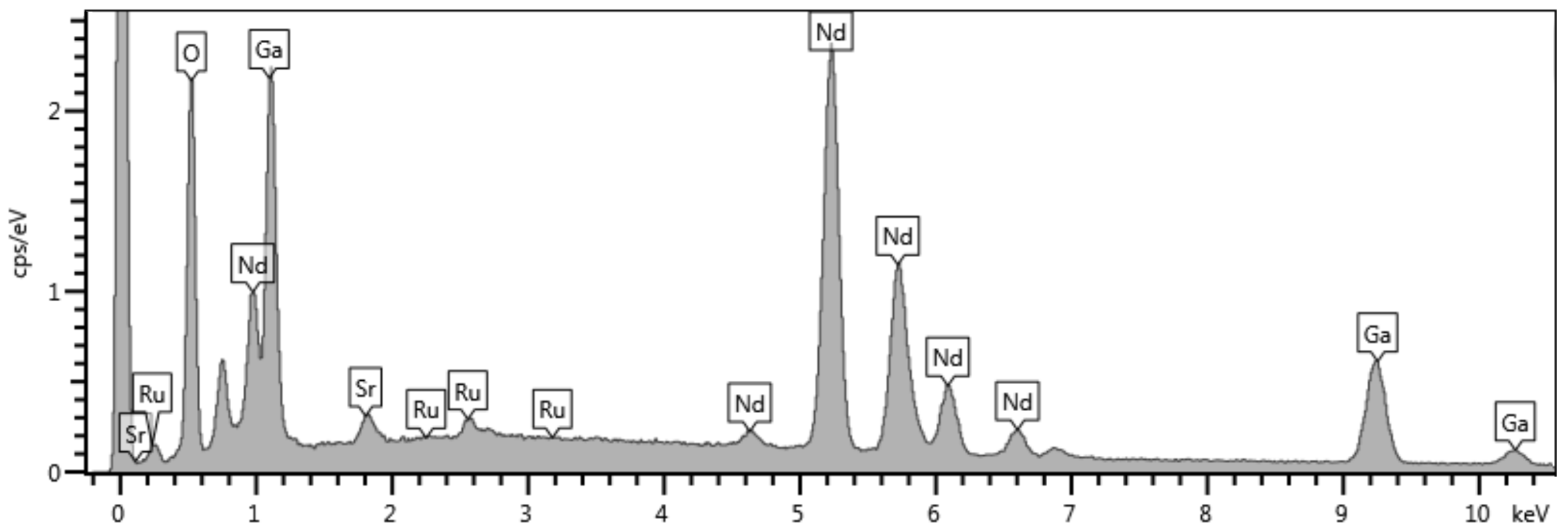
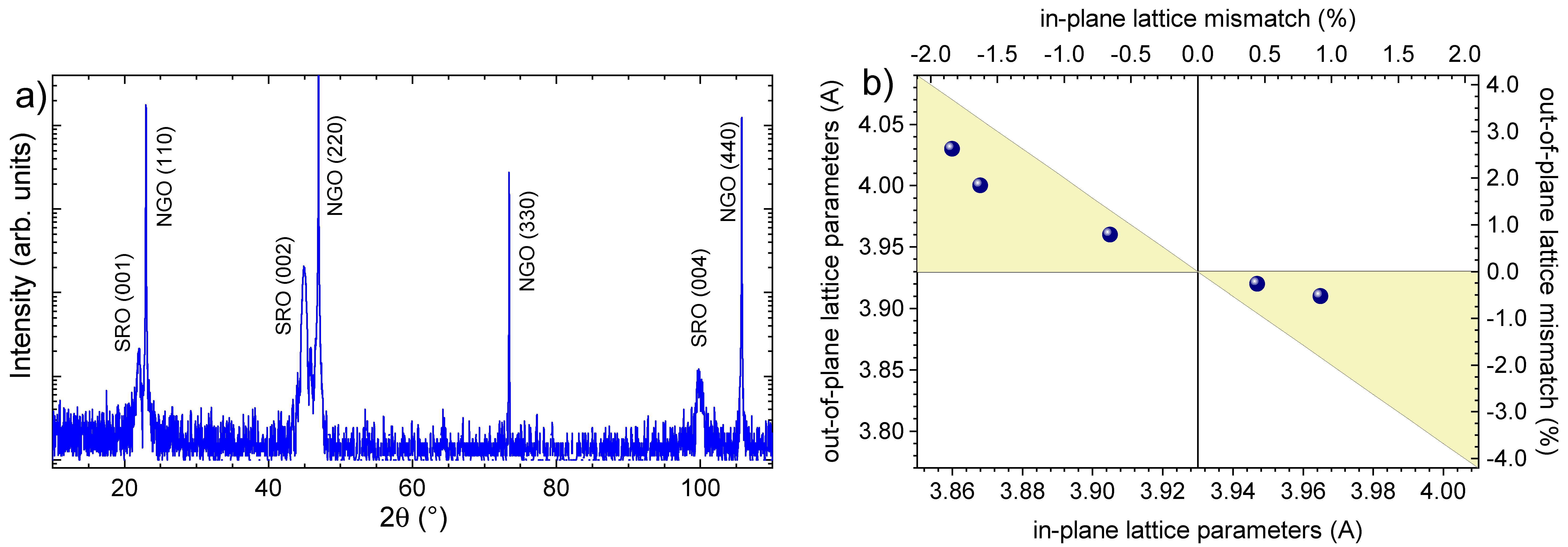

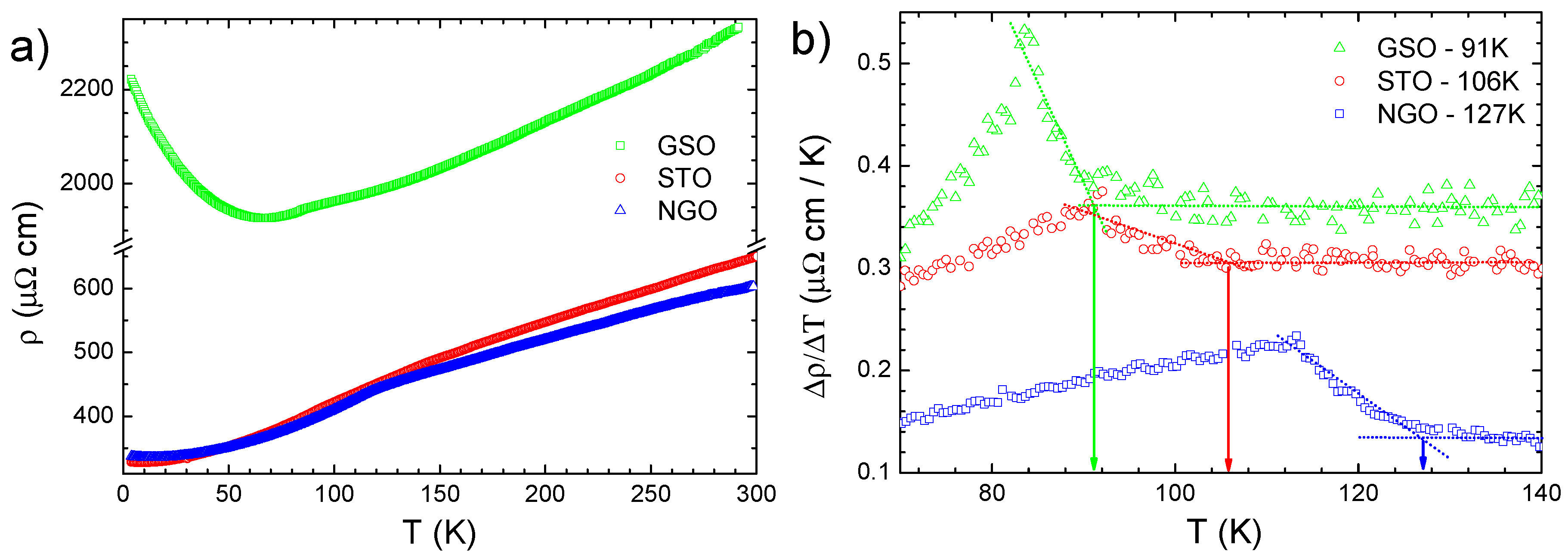
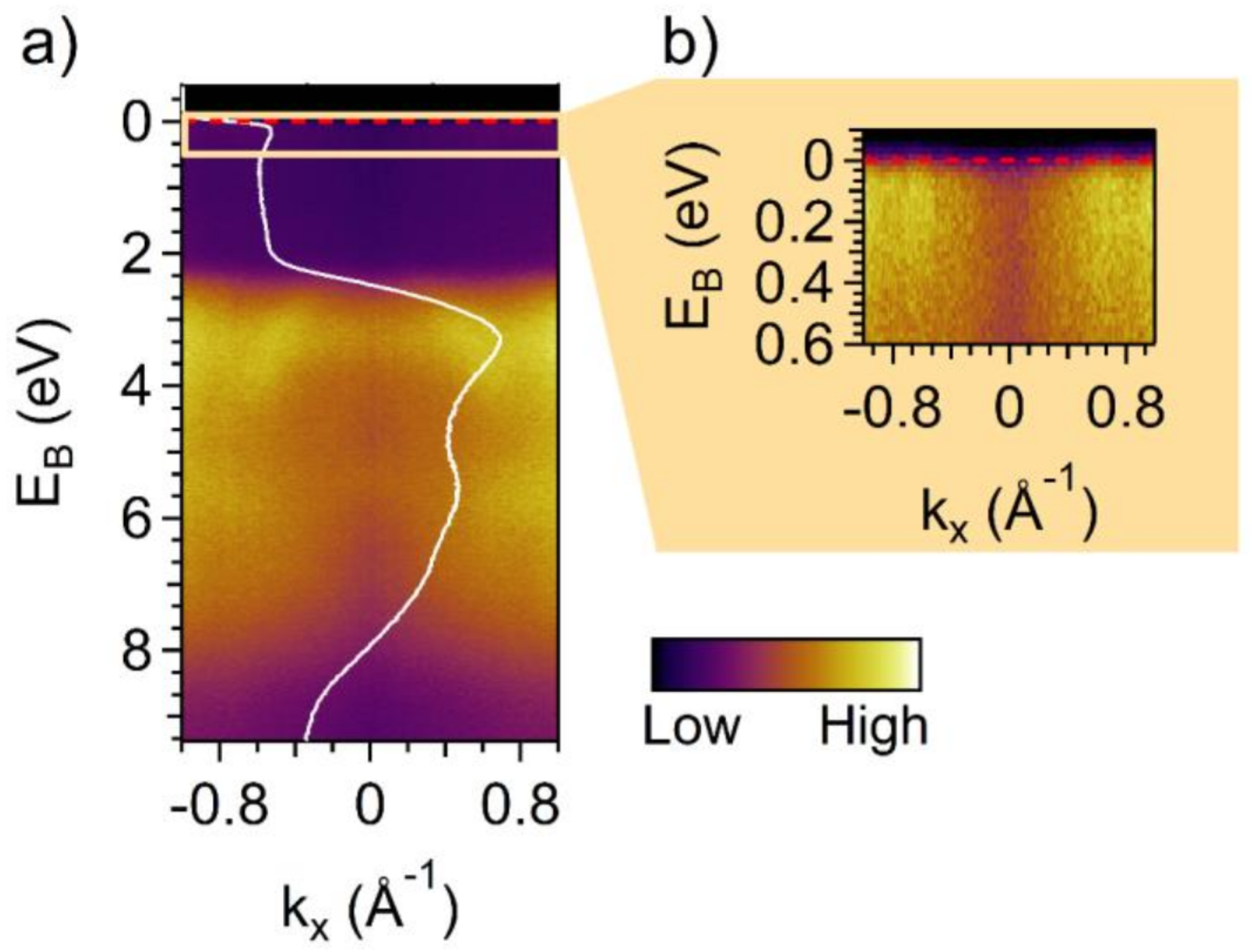
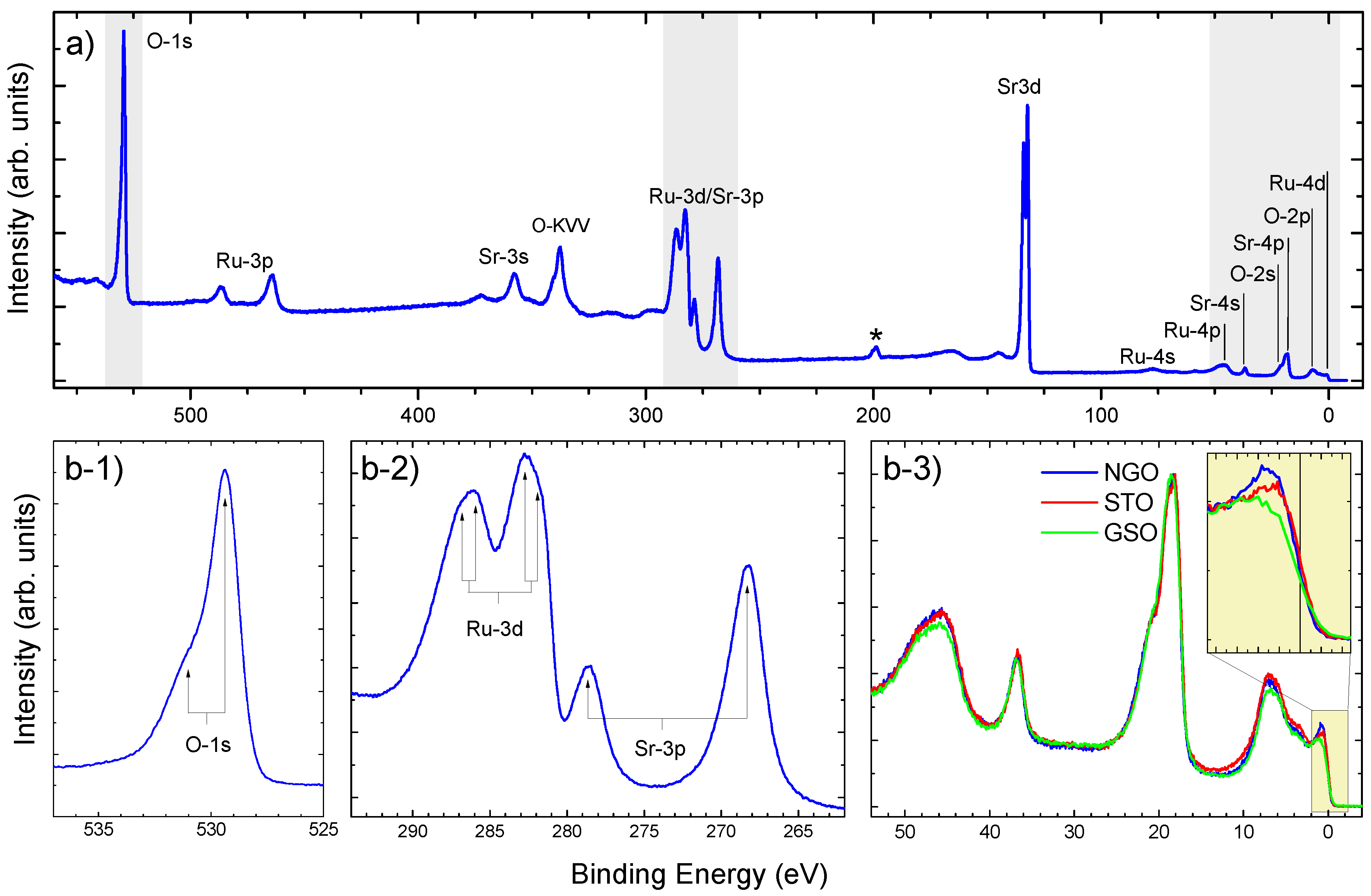
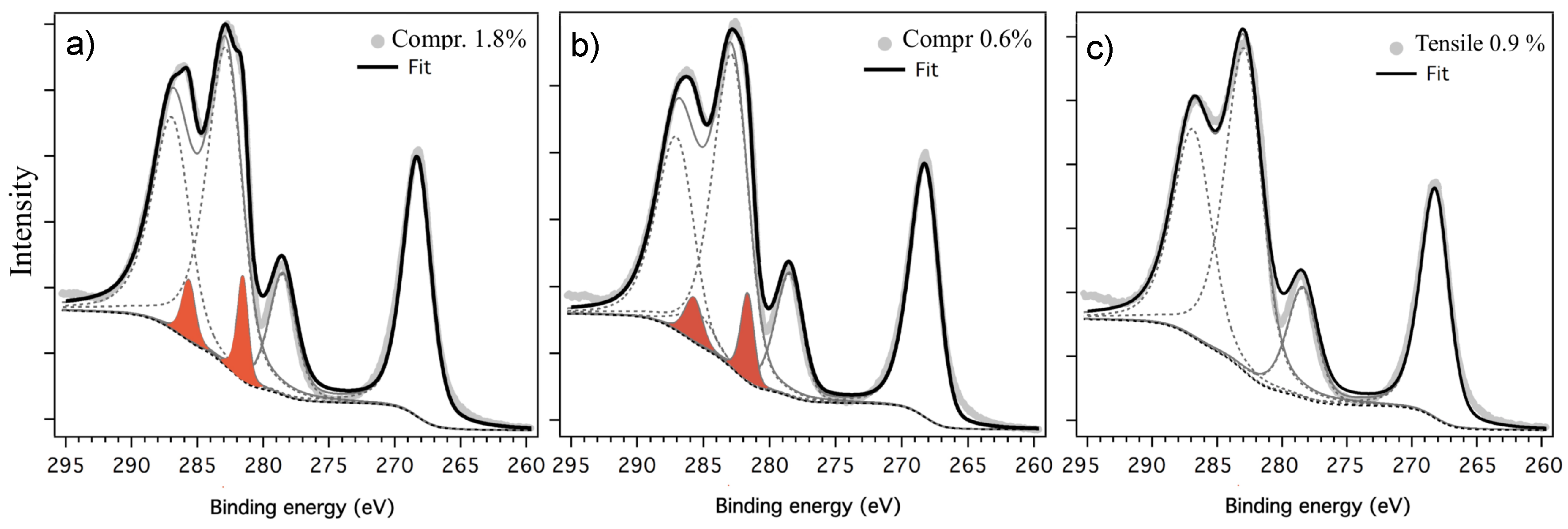
© 2020 by the authors. Licensee MDPI, Basel, Switzerland. This article is an open access article distributed under the terms and conditions of the Creative Commons Attribution (CC BY) license (http://creativecommons.org/licenses/by/4.0/).
Share and Cite
Nardi, A.; Bigi, C.; Kumar Chaluvadi, S.; Ciancio, R.; Fujii, J.; Vobornik, I.; Panaccione, G.; Rossi, G.; Orgiani, P. Analysis of Metal-Insulator Crossover in Strained SrRuO3 Thin Films by X-ray Photoelectron Spectroscopy. Coatings 2020, 10, 780. https://doi.org/10.3390/coatings10080780
Nardi A, Bigi C, Kumar Chaluvadi S, Ciancio R, Fujii J, Vobornik I, Panaccione G, Rossi G, Orgiani P. Analysis of Metal-Insulator Crossover in Strained SrRuO3 Thin Films by X-ray Photoelectron Spectroscopy. Coatings. 2020; 10(8):780. https://doi.org/10.3390/coatings10080780
Chicago/Turabian StyleNardi, Andrea, Chiara Bigi, Sandeep Kumar Chaluvadi, Regina Ciancio, Jun Fujii, Ivana Vobornik, Giancarlo Panaccione, Giorgio Rossi, and Pasquale Orgiani. 2020. "Analysis of Metal-Insulator Crossover in Strained SrRuO3 Thin Films by X-ray Photoelectron Spectroscopy" Coatings 10, no. 8: 780. https://doi.org/10.3390/coatings10080780
APA StyleNardi, A., Bigi, C., Kumar Chaluvadi, S., Ciancio, R., Fujii, J., Vobornik, I., Panaccione, G., Rossi, G., & Orgiani, P. (2020). Analysis of Metal-Insulator Crossover in Strained SrRuO3 Thin Films by X-ray Photoelectron Spectroscopy. Coatings, 10(8), 780. https://doi.org/10.3390/coatings10080780






